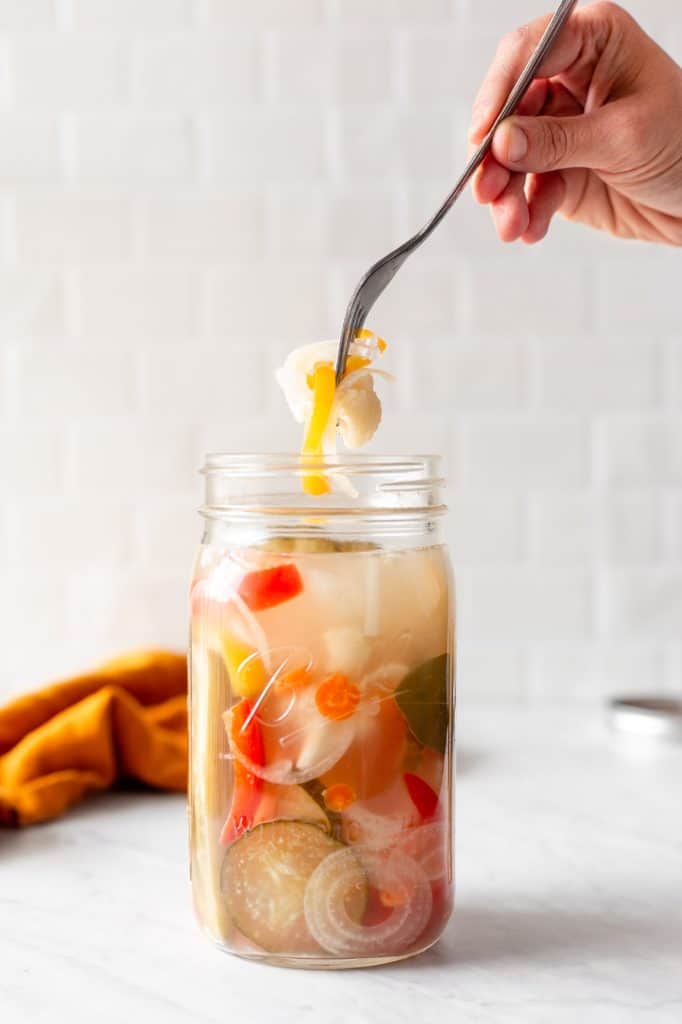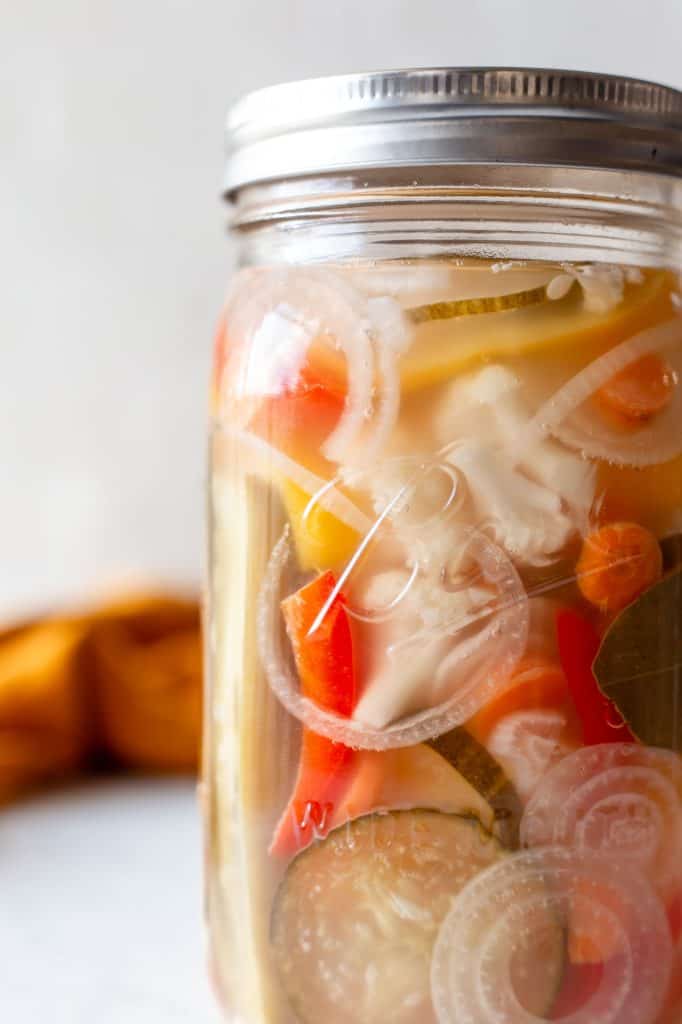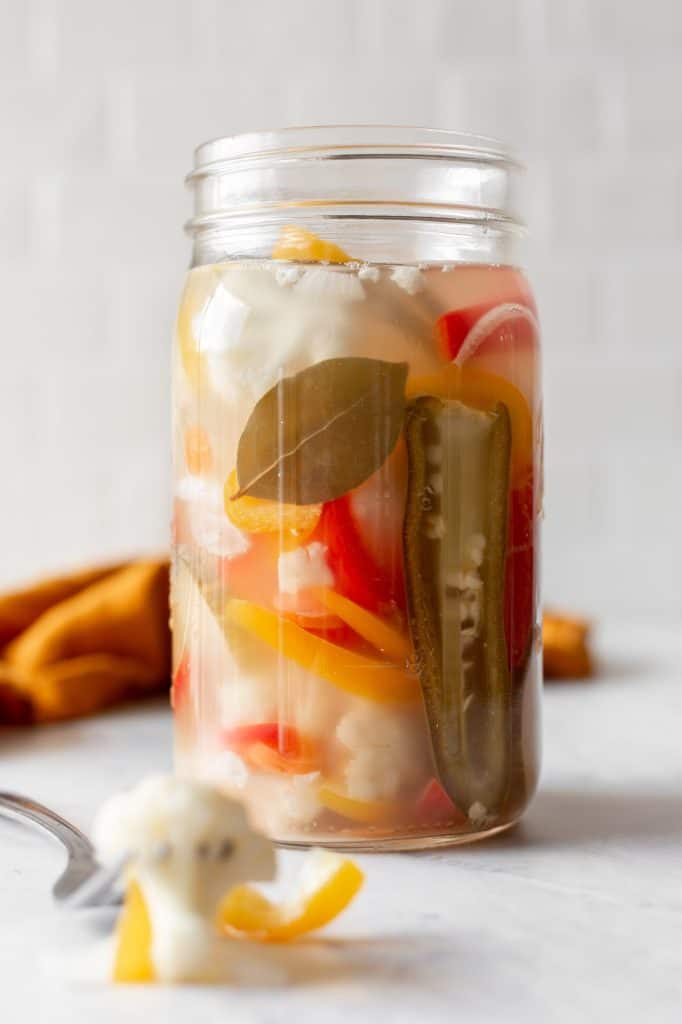Giardiniera is a mix of pickled vegetables in vinegar or oil in Italy, but here we used wild fermentation to create a delicious fermented Giardiniera. For this recipe, we developed a spicy, pleasantly sour preserved vegetable mix, made even more nutritious through fermentation. By the way, in Italian, it is pronounced jar-din-AIR-ah, and it literally means “from the garden.”

Choosing the Right Vegetables for Giardiniera Fermentation
- Pickled Italian Giardiniera usually includes bell peppers, celery, carrots, cauliflower and gherkins (tiny pickles).
- Good options for sourcing quality vegetables for fermentation are your local farmers market, Whole Foods Market, sprouts market, and open-aired produce stands. Many grocery stores have a fresh produce section, the key here is to use fresh vegetables not packaged in plastic.
- Make sure the vegetables are crisp, hydrated, and fresh. They should be free of any mold spots.
- For this recipe I used yellow bell peppers, red bell peppers, cucumbers, cauliflower, jalapeno, shallots and carrots.

Equipment You Need to Make Fermented Giardiniera
Here’s all the supplies and equipment you will need to make this recipe:
- sea salt
- water (tap works fine, but if your tap water is questionable use filtered)
- 1-quart glass mason jar with lid
- a glass Fermentation Weightfit to the mason jar
- Metal mason jar screw band or Rust Free Plastic Screw Band
- Kitchen scale
How Do You Eat Italian Giardiniera?
Traditionally in Italy Giardiniera is served with antipasto, a first course appetizer consisting of pickled vegetables, brined olives, artichokes and cured meats. Giardiniera is also very popular in Chicago, where it is used more as a condiment.
Giardiniera is wonderful on sandwiches, on pizza, in omelets, in frittatas, on veggie burgers, and in salads. You can even use it to top sourdough focaccia. I highly suggest mixing it in with pasta, brined olives, red wine vinegar and olive oil for a delicious pasta salad.
The Difference Between Pickling and Fermenting
Pickling and fermenting are very different processes. Pickling is a sterile process for preserving food. This means there are no microorganisms involved in the pickling process. This process utilizes hot acidic liquid to sterilize and preserve vegetables.
Fermentation is a living process, relying on acid production by beneficial microorganisms. Fermentation takes time and requires a specific salt concentration for consistency and safety. To read more about salt and fermentation click here.

Fermented Giardiniera Conditions
- 4 weeks of fermentation
- Approximate 3.0% total salt concentration
- Room temperature (60-78° F)
- Final pH around 3.8
- Store in refrigerator after fermentation for up to 2 years
More Fermentation Recipes to Try
- How to Make the Healthiest Naturally Fermented Garlic
- Simple Wild Fermented Shallots Recipe
- How to Ferment Sauerkraut with Orange, Sesame, and Ginger

Easy and Nutritious Fermented Giardiniera
Giardiniera is a mix of pickled vegetables in vinegar or oil in Italy, but here we used wild fermentation to create a delicious fermented Giardiniera. For this recipe, we developed a spicy, pleasantly sour preserved vegetable mix, made even more nutritious through fermentation. By the way, in Italian, it is pronounced jar-din-AIR-ah, and it literally means “from the garden.”
- Prep Time: 30 minutes
- Fermentation Time: 4 weeks
- Total Time: 672 hours 30 minutes
- Yield: 10 servings
- Category: Fermented Vegetables
- Method: Fermentation
- Cuisine: Italian
- Diet: Vegan
Ingredients
- 120 grams cauliflower
- 100 grams cucumber
- 100 grams bell pepper
- 50 grams jalapeño
- 30 grams shallots
- 50 grams carrots
- 500 grams water
- 28 grams salt
- 2 bay leaves
Instructions
- Lightly rinse all your vegetables in cool water and chop them to your desired consistency. I sliced the bell peppers in thin strips, broke apart the cauliflower, sliced the jalapeno in half, and sliced the cucumber, carrots, and shallots.
- Make sure all of your fermentation equipment has been cleaned and sanitized well.
- Dissolve 28 grams of sea salt in 500 grams of water to create a brine.
- In a clean mason jar add all of the vegetables and the bay leaves.
- Add all of the saltwater brine to the jar.
- Place a fermentation weight in the jar to keep all of the vegetables submerged. Place the mason jar lid on the jar and secure it in place.
- Ferment for 4 weeks at room temperature. About 2 to 3 days into fermentation, you will notice a lot of bubbles. Set the jar in a glass dish to prevent messes. Every 24 hours loosen the lid to burp the jar and let the gas out. This particular fermentation can get very bubbly. You can rinse the lid daily before replacing it to keep it clean.
- After 4 weeks of fermentation, remove the fermentation weight and check to make sure the pH is around 3.8
- Then move to refrigerated storage.
Notes
- this recipe is sized to fit a 1-quart mason jar
- You can use any ratios of vegetables you want, as long as the total weight of vegetables combined is 450 grams.
- fermented vegetables should keep for about 2 years in the fridge
Keywords: Italian, fermented, vegetables, Giardiniera
The post Easy and Nutritious Fermented Giardiniera appeared first on Cultured Guru.
-------------------------
By: Kaitlynn Fenley
Title: Easy and Nutritious Fermented Giardiniera
Sourced From: cultured.guru/blog/easy-and-nutritious-fermented-giardiniera?utm_source=rss&utm_medium=rss&utm_campaign=easy-and-nutritious-fermented-giardiniera
Published Date: Fri, 12 Nov 2021 22:57:25 +0000
Did you miss our previous article...
https://biohackersnews.com/gut-health/global-prebiotics-week
.png)








